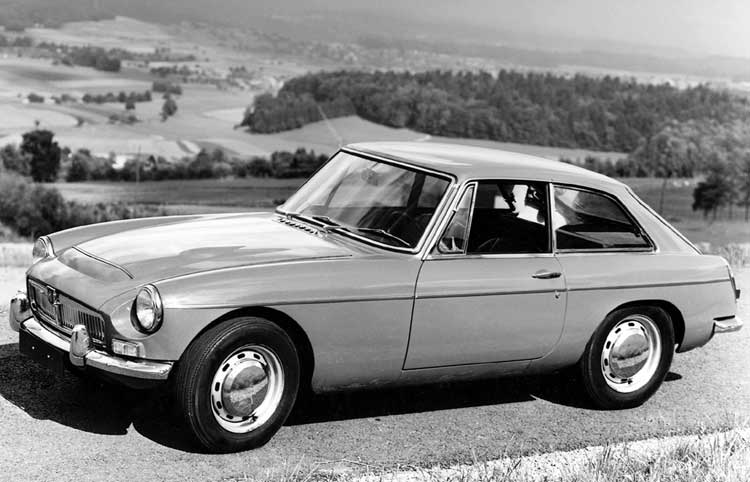MGC
The replacement for the Austin-Healey 3000 never took off, thanks in part to a poor press launch, says Keith Adams

Britain in the 1960s was a brilliant place for a single guy with money in his pocket and a hankering for something sporty to park outside his bachelor pad: he was surrounded by miniskirt-wearing, leggy dolly birds, was torn between The Beatles and The Stones, and had literally dozens of convertibles to choose from.
The only dilemmas our man about town would have faced were how deep his pockets were, and just how long a bonnet he preferred to sit behind.
The daddy of this halcyon market was the British Motor Corporation. Between Austin-Healey and MG, every sporting niche from 1.3 to 3 litres was covered. The corporation's products truly were the stuff of legend.
If you were particularly hairy-chested, the only option to go for was the Austin-Healey 3000 - the sonorous rally winner that demanded physical commitment from its driver. It might have seemed just a little antediluvian compared with newer offerings, yet despite this it was loved by a legion of fans across the world.
In short, the Austin-Healey 3000 was a car that needed special consideration when it came to the thorny subject of replacement.
Originally, BMC worked on a tailor-made replacement codenamed ADO30, but the proposal didn't go very far before being abandoned, and that left the company scratching around for a suitable car to fill the rapidly approaching void in the range.
However, as MG was working on a 3-litre version of the highly popular MGB (called the MGC and codenamed ADO52), the solution was obvious for students of corporate rationalisation: the re-engined B could be the new Healey.
On paper, it seemed like a plan, and once the Austin-Healey/MGC plan came to fruition, it then seemed logical to produce a Healey-fronted version (codenamed ADO51) to sell to those who didn't care for the octagon. However, this plan came up against problems - not least the fact that Donald Healey didn't like it, and rejected the idea out of hand. The Austin-Healey 3000, therefore, would not be replaced - even if BMC overlords said it had been.
The MGC should really have been a roaring success as, on paper, it had everything going for it. A lusty 2,912cc, straight-six upfront, and beautiful roadster and coupé body styles meant that the new MGC should have had the world at its feet - and an orderly queue of Terry-Thomas wannabes desperate for a piece of the action. With 145bhp to play with, it certainly went well, and MG engineers did a great job of counteracting the weight of this heavy power unit when installed in the lithe MG roadster.
However, BMC didn't have a great track record when it came to product launches. If it wasn't wearing down journalists with multiple unveilings of the same car wearing different badges, then it released cars to the public with a whole host of teething problems.
In the case of the MGC, the launch was banjanxed by the press office incorrectly pressuring the tyres. This might seem a minor problem, but when the car in question has a heavyweight truck engine and a tendency to understeer, imbalances in tyre pressures can make a world of difference.
With a paucity of air upfront, "slight" became "epic" in the understeer department, and polite road-testers were left to find new and inventive ways of slating the handling without resorting to barefaced insults. Potential buyers soon caught on, and, further discouraged by heavy steering and indifferent performance for the money, sales weren't particularly forthcoming.
Further problems for the MGC loomed on the horizon: BMC was about to be swallowed up by the Leyland Motor Company. That particular portfolio of companies already had a very capable range of Triumph sports cars - and the TR6 and MGC would be direct rivals. One of them would have to give. No prizes for guessing which was abandoned in a combined company dominated by Triumph management: it was goodbye, MGC.
Did the MGC deserve such an ignominious fate? Was it really that bad that it deserved to live a shorter life than the City Rover? That's a tough one to answer objectively, because, as a classic today, sitting on modern tyres and dampers, and tweaked to deliver a little more power, the C is actually a fine drive.
Not great, thanks to its set-in-concrete steering and lugubrious engine, but charismatic in a lazy-summer-evenings-in-the-countryside kind of way. Overall, though, it looks good, and makes a great open tourer. It can also be fixed by anyone with an ounce of technical savvy, or someone who has access to the million-and-one specialists in the UK.
Going back to 1966, though, was this car the winner it should have been? Not really - but even if the press garage had got the tyre pressures right, the MGC wouldn't have hit the spot. It wasn't the new Austin-Healey 3000 the world wanted, and that meant that its faults were doubly unforgiven.
It seems that our swinger about town wasn't ready to retire to the easy life of grand touring just yet.
Join our commenting forum
Join thought-provoking conversations, follow other Independent readers and see their replies
Comments
Bookmark popover
Removed from bookmarks